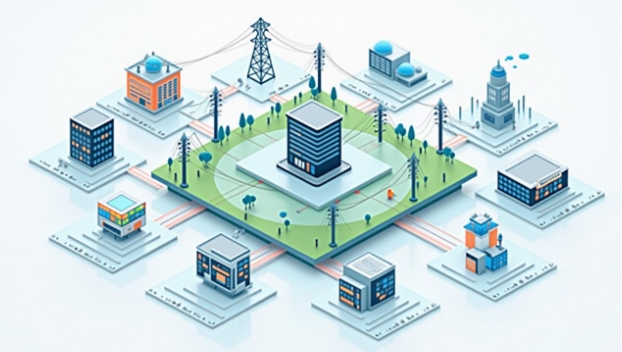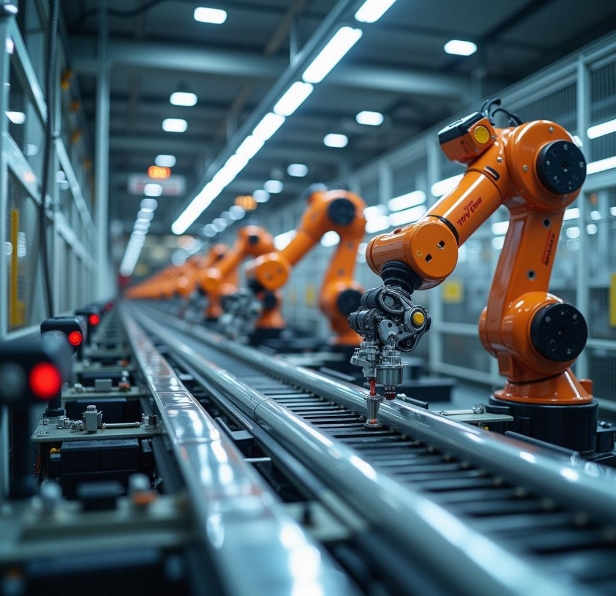Electronic and Electrical Industry Application Development Solutions
- latest articles
- 1.DApp Development & Customization: Merging Diverse Market Needs with User Experience 2.Analysis of the Core Technical System in DApp Project Development 3.How to achieve cross-chain interoperability in Web3 projects? 4.How does the tokenization of points reconstruct the e-commerce ecosystem? 5.How to Set and Track Data Metrics for a Points Mall? 6.What is DApp Development? Core Concepts and Technical Analysis 7.Inventory of commonly used Web3 development tools and usage tips 8.Development of a Distribution System Integrated with Social E-commerce 9.Six Key Steps for Businesses to Build a Points Mall System 10.What is DApp Development? A Comprehensive Guide from Concept to Implementation
- Popular Articles
- 1.Future Trends and Technology Predictions for APP Development in 2025 2.Analysis of the DeFi Ecosystem: How Developers Can Participate in Decentralized Finance Innovation 3.From Zero to One: How PI Mall Revolutionizes the Traditional E-commerce Model 4.DAPP Development | Best Practices for Professional Customization and Rapid Launch 5.Recommended by the Web3 developer community: the most noteworthy forums and resources 6.From Cloud Computing to Computing Power Leasing: Building a Flexible and Scalable Computing Resource Platform 7.How to Develop a Successful Douyin Mini Program: Technical Architecture and Best Practices 8.Shared Bike System APP: The Convenient Choice in the Era of Smart Travel 9.How to Create a Successful Dating App: From Needs Analysis to User Experience Design 10.From Design to Development: The Complete Process of Bringing an APP Idea to Life
As one of the important pillars of the modern economy, the electronics and electrical industry is widely applied across various fields, from consumer electronics to industrial automation, energy management, and further to industries such as smart transportation and medical devices. With the continuous advancement of technology, especially the development of information technology, the Internet of Things (IoT), big data, and artificial intelligence, the application scenarios of the electronics and electrical industry are becoming increasingly diverse. How to achieve efficient application development and solution deployment in such an environment is a major challenge currently faced by enterprises.
This article will explore application development solutions in the context of current trends in the electronics and electrical industry, focusing on technical architecture, system integration, intelligent applications, and data management to help related enterprises enhance application development efficiency, optimize resource allocation, and achieve continuous innovation and competitive advantage.
I. Background and Challenges of Application Development in the Electronics and Electrical Industry
1.1 Industry Development Trends
With the continuous advancement of global digital transformation, the electronics and electrical industry is undergoing profound changes. Particularly in areas such as industrial automation, smart manufacturing, power management, and green energy, application demands are rapidly increasing. The application of emerging technologies like the Internet of Things (IoT), artificial intelligence (AI), and big data is bringing new opportunities to the industry.
Intelligent Demand: Intelligent products and solutions are becoming mainstream in the market. Concepts such as smart homes, smart grids, and smart factories are continuously maturing.
Automation Development: The widespread application of industrial robots and automatic control systems has significantly improved production efficiency and safety.
Green Energy and Sustainable Development: The effective utilization of energy and the popularization of green electricity present new development opportunities for the electrical industry.
1.2 Challenges Faced
However, the electronics and electrical industry still faces a series of challenges in the application development process:
Complex System Integration Issues: The electronics and electrical industry often involves the integration of various devices, systems, and technologies. Achieving seamless connectivity and efficient collaboration between different systems has become a key issue.
Rapid Technological Updates: The fast-paced development of new technologies requires developers to continuously learn and keep up to ensure that products and systems can meet evolving demands.
Data Processing and Management: In the context of IoT and big data applications, efficiently handling and managing massive amounts of data is another challenge. Data security and privacy issues cannot be overlooked.
Diversity of Market Demands: Different industry applications have varying requirements, demanding that developers respond quickly to the market and provide flexible, customized solutions.

II. Technical Architecture for Application Development in the Electronics and Electrical Industry
When facing the aforementioned challenges, a well-designed technical architecture is crucial. A good technical architecture not only supports efficient application development but also enhances system scalability, maintainability, and security.
2.1 Layered Architecture Design
The technical architecture for applications in the electronics and electrical industry typically adopts a layered design, mainly including the following layers:
Perception Layer (Data Acquisition Layer): This layer is primarily responsible for integrating hardware such as devices and sensors, using IoT technology to achieve real-time collection of information like device status and environmental parameters. Common technologies include sensors, smart meters, and wireless communication.
Transmission Layer (Data Transmission Layer): After data acquisition, it needs to be transmitted to the central processing system via communication networks. This layer typically uses technologies such as industrial internet, 5G networks, Wi-Fi, and LoRa to ensure data timeliness and reliability.
Processing Layer (Data Processing Layer): This layer is responsible for processing, analyzing, and making decisions based on the collected data. It often combines technologies like cloud computing, big data, and edge computing, utilizing AI algorithms and machine learning models to analyze data and perform tasks such as prediction and optimization.
Application Layer (Application Execution Layer): This layer directly interfaces with users and is responsible for implementing specific business logic and application functions. Common applications in the electronics and electrical industry include smart grid management, industrial automation control, energy optimization, and equipment failure prediction.
Service Layer (Support and Maintenance Layer): This layer provides ongoing system operation and support services, including monitoring, maintenance, upgrades, and troubleshooting.
2.2 Microservices Architecture
In modern application development, microservices architecture has gradually become mainstream, especially in scenarios requiring high scalability and concurrency, where it demonstrates significant advantages. By breaking down the entire system into multiple independent small services, development teams can flexibly develop, deploy, maintain, and scale individual service modules.
In applications within the electronics and electrical industry, microservices architecture is particularly suitable for the following scenarios:
Distributed Control Systems: For large-scale industrial automation systems, using microservices can better distribute processing and control tasks, ensuring high availability and flexibility.
Energy Management: Energy management systems often involve multiple subsystems; using microservices architecture allows for independent optimization and upgrades of different modules.
Smart Grids: Smart grid systems involve various devices and complex control logic; microservices architecture facilitates distributed deployment and rapid response.
2.3 Integration of Cloud Computing and Edge Computing
With the increase in IoT devices and growing data volumes, the combination of cloud computing and edge computing has become an effective way to enhance system performance and response speed. Cloud computing provides powerful computing and storage capabilities, while edge computing processes data closer to the source, reducing latency and bandwidth pressure.
For applications in the electronics and electrical industry, especially those with high real-time requirements, the integration of edge and cloud computing offers the following advantages:
Real-Time Data Processing: Edge computing can handle real-time data, reducing the delay in transmitting data to the cloud and improving response speed.
Big Data Analysis: Cloud computing can process large-scale data, enabling in-depth analysis and decision support to optimize overall operational efficiency.
III. Intelligent Applications and Big Data Analysis
3.1 Enhancement of Intelligent Applications
Intelligence is a key trend in application development for the electronics and electrical industry. By applying artificial intelligence (AI) and machine learning (ML) technologies, the automation and intelligence levels of systems can be significantly improved. For example, in smart grids, AI can help analyze power loads, predict energy demands, and perform intelligent scheduling, thereby optimizing power resource allocation and reducing energy waste.
Equipment Failure Prediction and Maintenance: Through real-time monitoring and data analysis of equipment, machine learning algorithms can predict potential equipment failures in advance and issue maintenance alerts. This not only extends equipment lifespan but also reduces downtime and maintenance costs.
Smart Grids: AI and machine learning technologies can use big data analysis to predict fluctuations in power demand, perform load regulation and intelligent scheduling, thereby enhancing grid stability and power utilization efficiency.
3.2 Data Analysis and Decision Support
Data is a vital asset in the electronics and electrical industry. Extracting valuable information from massive data for analysis has become key to enhancing enterprise competitiveness. Through big data analysis technologies, enterprises can gain deep insights into production, equipment, energy usage, and more, thereby supporting decision-making.
Energy Management and Optimization: Big data technology can help enterprises monitor energy consumption in real-time, identify energy waste and optimization opportunities, and provide data-driven energy management solutions.
Production Process Optimization: By analyzing production data, production processes can be optimized, efficiency improved, and future production demands predicted, helping enterprises develop more scientific production plans.

IV. System Integration and Security in Application Development
4.1 Challenges and Solutions in System Integration
Application development in the electronics and electrical industry often requires integrating various devices and systems, including sensors, control systems, and data acquisition modules. The difficulty in system integration lies in the differences in data formats, communication protocols, and functional requirements between different systems. To achieve efficient integration, enterprises need to adopt open standards and protocols for cross-platform data interconnection and business process optimization.
Common system integration solutions include:
Standardized Communication Protocols: Such as Modbus, OPC, MQTT, etc., which ensure data exchange between different devices.
Industrial Bus Technologies: Such as CAN bus, Profibus, etc., which help achieve efficient connectivity of field devices.
Integration of Cloud Platforms and Local Systems: By combining cloud platforms with local devices, data flow is ensured to be smooth and real-time.
4.2 Security and Privacy Protection
With the deepening development of applications in the electronics and electrical industry, data security and privacy issues have become urgent challenges. Especially in the context of intelligent and IoT applications, ensuring the security of devices, networks, data, and user privacy has become a critical issue for enterprises.
Data Encryption and Authentication: Ensuring the security of information transmission through data encryption and identity authentication.
Network Security Protection: Strengthening network monitoring and using technologies such as firewalls and intrusion detection to prevent hacker attacks and data leaks.
V. Conclusion
Application development solutions in the electronics and electrical industry cover multiple aspects, from data acquisition and real-time monitoring to intelligent decision-making and resource optimization. Driven by intelligence, automation, and big data, various applications within the industry continue to deepen, promoting the rapid development of the electrical industry.
In practical applications, different industries and scenarios have varying requirements for technical architecture, system integration, data analysis, etc. Therefore, application development solutions in the electronics and electrical industry must possess high flexibility and customization capabilities. By leveraging advanced technologies such as cloud computing, artificial intelligence, and the Internet of Things, enterprises can achieve intelligent device management, efficient system operation, and optimized energy utilization, thereby enhancing overall operational efficiency and competitiveness.
With continuous technological advancements and evolving market demands, the electronics and electrical industry will witness more innovative applications and solutions in the future. Whether in industrial automation, smart grids, smart homes, or smart transportation, application development in the electronics and electrical industry will bring more opportunities to enterprises and create greater value for society.
-

How to Use App Development to Boost Conversion Rates on E-commerce Platforms
With the widespread adoption of smartphones and the rapid development of mobile ···
-

How APP Development Facilitates Digital Transformation and Innovation
With the rapid advancement of information technology, digital transformation has···
-

App Store Optimization and SEO Strategies in App Development
In today's rapidly evolving mobile internet landscape, apps have become essentia···

 Blockchain
Blockchain










